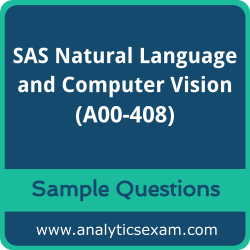To make your preparation easier for the SAS A00-408 exam, we strongly recommend you to use our Premium SAS Natural Language and Computer Vision Certification Practice Exam. According to our survey with certified candidates, you can easily score more than 85% in your actual SAS Certified Specialist - Natural Language Processing and Computer Vision Using SAS Viya exam if you score 100% in our premium certification practice exams.
01. Which is NOT a useful method of regularization when training a Convolutional Neural Network?
a) Adding a dropout layer
b) Adding fully connected layers
c) Penalizing the cost function
d) Early stopping
02. A documents data set has a document ID, a text variable, and 3 category variables. There is a total of 13 topics. A unique ID (__uniqueid__) has been added to the output data set. How many columns are in the output data set obtained from the results window of the Topics node?
a) 29
b) 19
c) 32
d) 16
03. Which statement is TRUE regarding encoding?
a) Latin encoding is an extension of ASCII encoding with specific extensions.
b) Asian languages (i.e. Japanese) are typically encoded in ASCII.
c) UTF-8 is a subset of ASCII encoding.
d) A UTF-8 character is 4 bytes long.
04. When scoring new images with a neural network using dlScore, which statement is TRUE about the weights?
a) The weights change due to backpropagation.
b) The weights do not change.
c) The weights change due to covariate shift of the distribution of new images.
d) The weights change only when there is a new image that is significantly different from the training images.
05. Which statement is FALSE when you use dlTune to tune the hyperparameters of CNN?
a) It tunes learning rate.
b) It tunes miniBatchSize.
c) It tunes model architecture
d) It tunes momentum rate.
06. The output for a particular neuron in the hidden layer is -0.001. What activation function is used in this hidden layer?
a) TanH
b) RelU
c) Sigmoid
d) Softmax
07. Which statements are TRUE regarding the creation of automatic custom concept rules from textual elements in the Concept node?
(Choose two.)
a) Text Parsing node must precede a Concept node in the pipeline when creating automatic custom concept rules from textual elements.
b) The automatic custom concept rules generated from textual elements in the Concept node is the PREDICATE_RULE type only.
c) The textual elements available for writing concept rules are comprised of all terms generated by the Text Parsing node.
d) The automatic custom concept rules generated from textual elements in the concept node is CONCEPT_RULE type only.
08. What is a criticism of the pooling operation?
a) Complicates the loss (cost) function.
b) Increases the model parameters.
c) Overemphasizes the tails of the input distribution.
d) Increases the degradation of spatial information.
09. Which statement is FALSE regarding the loadImages action?
a) All images are represented in a single table after loading.
b) Images can be 3-dimensional.
c) Images from multiple sources can be loaded in a single call.
d) Encoded images must be decoded prior to loading.
10. Assume a feature set defined by a 244*244*12 tensor. This is layer A. A 7*7 filter with stride of 1 is applied to layer A resulting in layer B. Another 7*7 filter with stride of 1 is applied to layer B resulting in layer C. What padding must be used to allow for a skip connection from A to C?
a) 1
b) 2
c) 3
d) 4
Equip yourself with the best resources and practice exams to ace your SAS Certified Specialist - Natural Language Processing and Computer Vision Using SAS Viya exam. Explore our comprehensive study materials and take the first step towards certification success.
 Welcome! Preparing for the SAS Viya Natural Language Processing and Computer Vision (A00-408) certification exam can be a daunting task, but we're here to make it easier for you. Here are the sample questions that will help you become familiar with the SAS A00-408 exam style and structure. We encourage you to try our Demo SAS Natural Language and Computer Vision Certification Practice Exam to measure your understanding of the exam structure in an environment that simulates the actual test environment.
Welcome! Preparing for the SAS Viya Natural Language Processing and Computer Vision (A00-408) certification exam can be a daunting task, but we're here to make it easier for you. Here are the sample questions that will help you become familiar with the SAS A00-408 exam style and structure. We encourage you to try our Demo SAS Natural Language and Computer Vision Certification Practice Exam to measure your understanding of the exam structure in an environment that simulates the actual test environment.